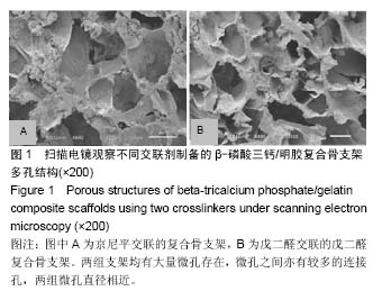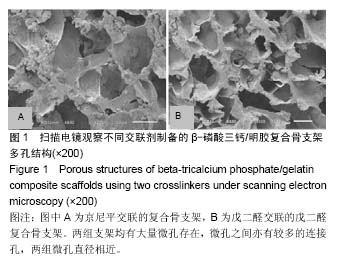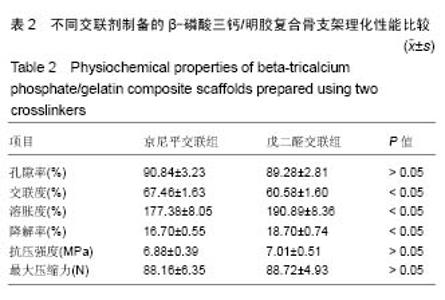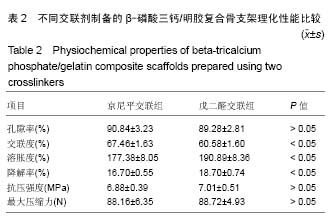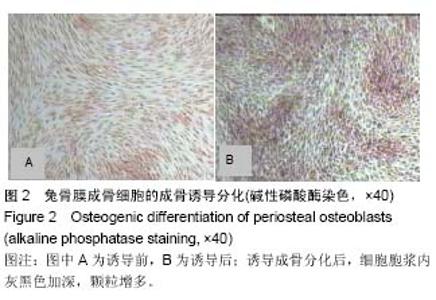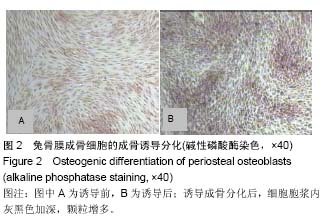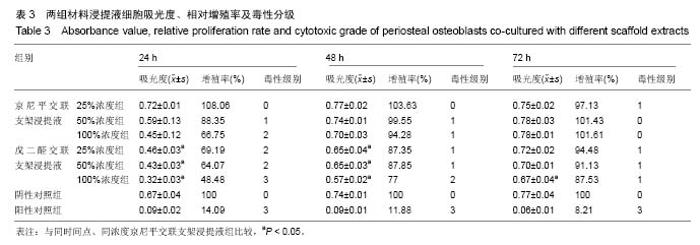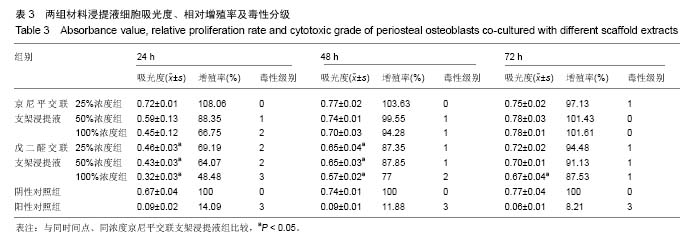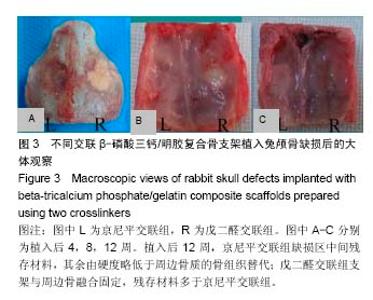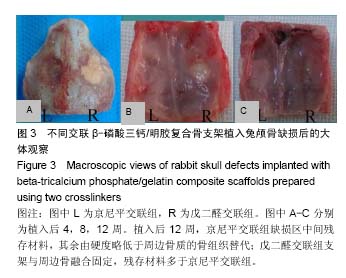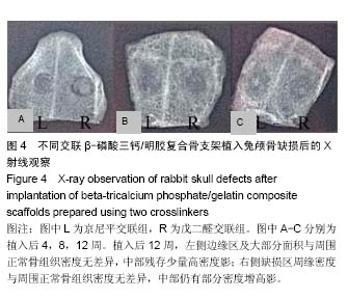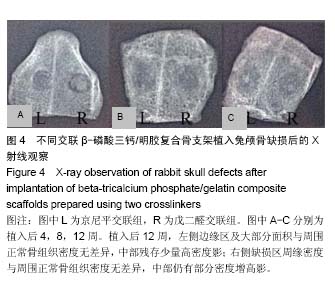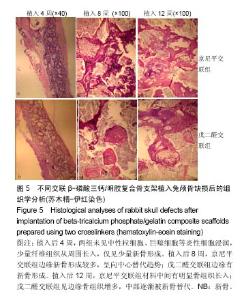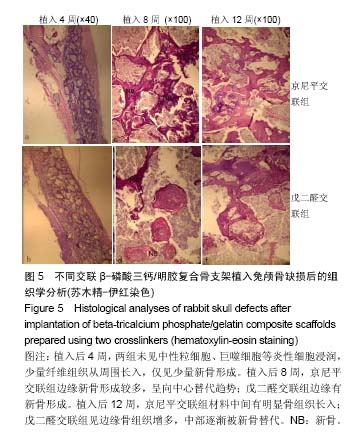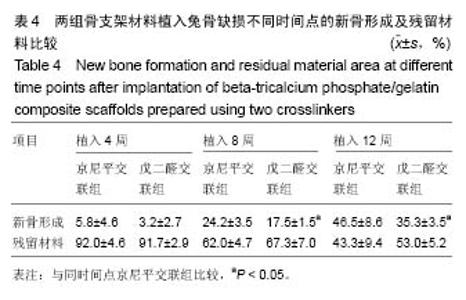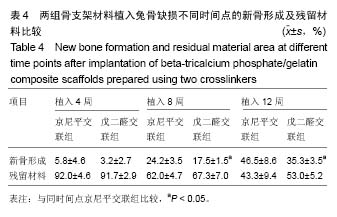Chinese Journal of Tissue Engineering Research ›› 2018, Vol. 22 ›› Issue (6): 833-839.doi: 10.3969/j.issn.2095-4344.0055
Previous Articles Next Articles
Influence of two different crosslinkers on physiochemical properties and bioactivity of a composite bone scaffold composed of beta-tricalcium phosphate and gelatin
- Orthopedics Institute of Chinese PLA, the 89th Hospital of PLA, Weifang 261021, Shandong Province, China
-
Received:2017-09-11Online:2018-02-28Published:2018-02-28 -
About author:Pan Zhao-hui, M.D., Associate chief physician, Orthopedics Institute of Chinese PLA, the 89th Hospital of PLA, Weifang 261021, Shandong Province, China -
Supported by:the General Project of the Twelfth Five-Year Program of Chinese PLA, No. CWS11J245
CLC Number:
Cite this article
Pan Zhao-hui, Luan Zhao-xin, Gao Peng . Influence of two different crosslinkers on physiochemical properties and bioactivity of a composite bone scaffold composed of beta-tricalcium phosphate and gelatin[J]. Chinese Journal of Tissue Engineering Research, 2018, 22(6): 833-839.
share this article
Add to citation manager EndNote|Reference Manager|ProCite|BibTeX|RefWorks
| [1]Pawelec KM,Confalonieri D,Ehlicke F,et al.Osteogenesis and mineralization of mesenchymal stem cells in collagen type Ⅰ-based recombinant peptide scaffolds.J Biomed Mater Res Part A.2017;105(7):1856-1866.[2]Kuttappan S,Mathew D,Nair MB,et al.Biomimetic composite scaffolds containing bioceramics and collagen/gelatin for bone tissue engineering-A mini review.Int J Biol Macromol.2016;93 (Pt B):1390-1401.[3]Dong GC,Chen HM,Yao CH.A novel bone substitute composite composed of tricalcium phosphate, gelatin and drynaria fortunei herbal extract.J Biomed Mater Res A.2008;84(1):167-177.[4]Hu Q,Li B,Wang M,et al.Preparation and characterization of biodegradable chitosan/hydroxyapatite nanocomposite rods via in situ hybridization: a potential material as internal fixation of bone fracture.Biomaterials.2004;25(5):79-785.[5]Greco KV,Francis L,Huang H,et al.Is quercetin an alternative natural crosslinking agent to genipin for long term dermal scaffolds implantation ? J Tissue Eng Regen Med.2016. doi:10.1002/term.2338.[Epub ahead of print][6]Zhang Y,Wang QS,Yan K,et al.Preparation, characterization, and evaluation of genipin crosslinked chitosan/gelatin three-dimensional scaffolds for liver tissue engineering applications.J Biomed Mater Res Part A.2016;104(8):1863-1870.[7]Tseng HJ,Tsou TL,Wang HJ,et al.Characterization of chitosan-gelatin scaffolds for dermal tissue engineering.J Tissue Eng Regen Med.2013;7(1):20-31.[8]Peng YY,Glattauer V,Ramshaw J.Stabilisation of collagen sponges by glutaraldehyde vapour crosslinking.Int J Biomater. 2017;2017:8947823.[9]Suesca E,Dias A,Braga M,et al.Multifactor analysis on the effect of collagen concentration, cross-linking and fiber/pore orientation on chemical,microstructural, mechanical and biological properties of collagen typeⅠ scaffolds.Mater Sci Eng C Mater Biol Appl. 2017;77:333-341.[10]Madhavan K,Belchenko D,Motta A,et al.Evaluation of composition and crosslinking effects on collagen-based composite constructs. Acta Biomater.2010;6(4):1413-1422.[11]Yao CH,Liu BS,Hsu SH,et al.Calvarial bone response to a tricalcium phosphate-genipin crosslinked gelatin composite. Biomaterials.2005;26(16):3065-3074.[12]金勋杰,闫景龙,周磊,等.京尼平交联明胶特性随时间变化的研究[J].生物医学工程学杂志,2008,25(1):150-153.[13]Liu HC,Yao CH,Sun JS,et al.Osteogenic evaluation of glutaraldehyde crosslinked gelatin composite with fetal rat calvarial culture model.Artif Organs.2001;25(8):644-654.[14]Takahashi Y,Yamamoto M,Tabata Y.Enhanced osteoinduction by controlled release of bonemorphogenetic protein-2 from biodegradable sponge composed of gelatin and β-tricalcium phosphate.Biomaterials.2005;26(17):4856-4865.[15]Mi FL,Tan YC,Liang HF,et al.In vivo biocompatibility and degradability of a novel injectable-chitosan-based implant. Biomaterials.2002;23(1):181-191.[16]Liu BS,Yao CH,Chen YS,et al.In vitro evaluation of degradation and cytotoxicity of a novel composite as a bone substitute.J Biomed Mater Res A.2003;67(4):1163-1169.[17]李静,张富强,靳喜海.纳米羟基磷灰石-氧化锆复合陶瓷体外细胞毒性研究[J].北京口腔医学,2004,12(4):191-194. [18]孔晓霞,王鸾鸾,侯丽.不同振荡条件下制备的某种含银敷料的细胞毒性试验[J].生物医学工程研究, 2014,33(3):189-192.[19]Mohseni M,Jahandideh A,Abedi G,et al.Assessment of tricalcium phosphate/collagen (TCP/collagene)nanocomposite scaffold compared with hydroxyapatite (HA) on healing of segmental femur bone defect in rabbits.Artif Cells Nanomed Biotechnol. 2017;14:1-8.[20]Pawelec KM,Confalonieri D,Ehlicke F,et al.Osteogenesis and mineralization of mesenchymal stem cells in collagen typeⅠ-based recombinant peptide scaffolds.J Biomed Mater Res Part A. 2017;105(7):1856-1866.[21]潘朝晖,薛山,赵玉祥,等.多孔生物陶瓷人工骨修复儿童良性骨肿瘤刮除术后骨缺损[J].生物骨科材料与临床研究, 2017,14(3):24-27. [22]刘家祺.Beta-磷酸三钙复合材料支架的研究进展[J].中国美容医学, 2011,20(4):688-691. [23]Nayak S,Talukdar S,Kundu S.Potential of 2D crosslinked sericin membranes with improved biostability for skin tissue engineering. Cell Tissue Res.2012;347(3):783-794.[24]叶漫文,方炜,石勇,等.京尼平交联丝素蛋白-壳聚糖缓释微球的制备与表征[J].口腔疾病防治,2016,24(2):79-87.[25]Sung HW,Chang Y,Liang IL,et a1.Fixation of biological tissues with a naturally occurring crossing agent: fixation rate and effects of PH, temperature, and initial fixative concentration.J Biomed Mater Res.2000;52(1):77-87.[26]Khan MN,Islam JM,Khan MA.Fabrication and characterization of gelatin-based biocompatible porous composite scaffold for bone tissue engineerin.J Biomed Mater Res A.2012;100(11):3020-3028.[27]Yao CH,Liu BS,Hsu SH,et al.Biocompatibility and biodegradation of a bone composite containing tricalcium phosphate and genipin crosslinked gelatin.J Biomed Mater Res.2004;69(4):709-717.[28]Vatankhah E,Prabhakaran MP,Jin G,et al.Development of nanofibrous cellulose acetate/gelatin skin substitutes for variety wound treatment applications.J Biomater Appl.2014;28(6):909-921.[29]Charulatha V,Rajaram A.Influence of different crosslinking treatments on the physical properties of collagen membranes. Biomaterials.2003;24(5):759-767.[30]Cavalcanti SC,Pereira CL,Mazzonetto R,et al.Histological and histomorphometric analyses of calcium phosphate cement in rabbit calvaria.J Craniomaxillofac Surg.2008;36(6):354-359. |
| [1] | Zhang Tongtong, Wang Zhonghua, Wen Jie, Song Yuxin, Liu Lin. Application of three-dimensional printing model in surgical resection and reconstruction of cervical tumor [J]. Chinese Journal of Tissue Engineering Research, 2021, 25(9): 1335-1339. |
| [2] | Zeng Yanhua, Hao Yanlei. In vitro culture and purification of Schwann cells: a systematic review [J]. Chinese Journal of Tissue Engineering Research, 2021, 25(7): 1135-1141. |
| [3] | Xu Dongzi, Zhang Ting, Ouyang Zhaolian. The global competitive situation of cardiac tissue engineering based on patent analysis [J]. Chinese Journal of Tissue Engineering Research, 2021, 25(5): 807-812. |
| [4] | Wu Zijian, Hu Zhaoduan, Xie Youqiong, Wang Feng, Li Jia, Li Bocun, Cai Guowei, Peng Rui. Three-dimensional printing technology and bone tissue engineering research: literature metrology and visual analysis of research hotspots [J]. Chinese Journal of Tissue Engineering Research, 2021, 25(4): 564-569. |
| [5] | Chang Wenliao, Zhao Jie, Sun Xiaoliang, Wang Kun, Wu Guofeng, Zhou Jian, Li Shuxiang, Sun Han. Material selection, theoretical design and biomimetic function of artificial periosteum [J]. Chinese Journal of Tissue Engineering Research, 2021, 25(4): 600-606. |
| [6] | Liu Fei, Cui Yutao, Liu He. Advantages and problems of local antibiotic delivery system in the treatment of osteomyelitis [J]. Chinese Journal of Tissue Engineering Research, 2021, 25(4): 614-620. |
| [7] | Li Xiaozhuang, Duan Hao, Wang Weizhou, Tang Zhihong, Wang Yanghao, He Fei. Application of bone tissue engineering materials in the treatment of bone defect diseases in vivo [J]. Chinese Journal of Tissue Engineering Research, 2021, 25(4): 626-631. |
| [8] | Zhang Zhenkun, Li Zhe, Li Ya, Wang Yingying, Wang Yaping, Zhou Xinkui, Ma Shanshan, Guan Fangxia. Application of alginate based hydrogels/dressings in wound healing: sustained, dynamic and sequential release [J]. Chinese Journal of Tissue Engineering Research, 2021, 25(4): 638-643. |
| [9] | Chen Jiana, Qiu Yanling, Nie Minhai, Liu Xuqian. Tissue engineering scaffolds in repairing oral and maxillofacial soft tissue defects [J]. Chinese Journal of Tissue Engineering Research, 2021, 25(4): 644-650. |
| [10] | Xing Hao, Zhang Yonghong, Wang Dong. Advantages and disadvantages of repairing large-segment bone defect [J]. Chinese Journal of Tissue Engineering Research, 2021, 25(3): 426-430. |
| [11] | Chen Siqi, Xian Debin, Xu Rongsheng, Qin Zhongjie, Zhang Lei, Xia Delin. Effects of bone marrow mesenchymal stem cells and human umbilical vein endothelial cells combined with hydroxyapatite-tricalcium phosphate scaffolds on early angiogenesis in skull defect repair in rats [J]. Chinese Journal of Tissue Engineering Research, 2021, 25(22): 3458-3465. |
| [12] | Wang Hao, Chen Mingxue, Li Junkang, Luo Xujiang, Peng Liqing, Li Huo, Huang Bo, Tian Guangzhao, Liu Shuyun, Sui Xiang, Huang Jingxiang, Guo Quanyi, Lu Xiaobo. Decellularized porcine skin matrix for tissue-engineered meniscus scaffold [J]. Chinese Journal of Tissue Engineering Research, 2021, 25(22): 3473-3478. |
| [13] | Mo Jianling, He Shaoru, Feng Bowen, Jian Minqiao, Zhang Xiaohui, Liu Caisheng, Liang Yijing, Liu Yumei, Chen Liang, Zhou Haiyu, Liu Yanhui. Forming prevascularized cell sheets and the expression of angiogenesis-related factors [J]. Chinese Journal of Tissue Engineering Research, 2021, 25(22): 3479-3486. |
| [14] | Liu Chang, Li Datong, Liu Yuan, Kong Lingbo, Guo Rui, Yang Lixue, Hao Dingjun, He Baorong. Poor efficacy after vertebral augmentation surgery of acute symptomatic thoracolumbar osteoporotic compression fracture: relationship with bone cement, bone mineral density, and adjacent fractures [J]. Chinese Journal of Tissue Engineering Research, 2021, 25(22): 3510-3516. |
| [15] | Liu Liyong, Zhou Lei. Research and development status and development trend of hydrogel in tissue engineering based on patent information [J]. Chinese Journal of Tissue Engineering Research, 2021, 25(22): 3527-3533. |
| Viewed | ||||||
|
Full text |
|
|||||
|
Abstract |
|
|||||
